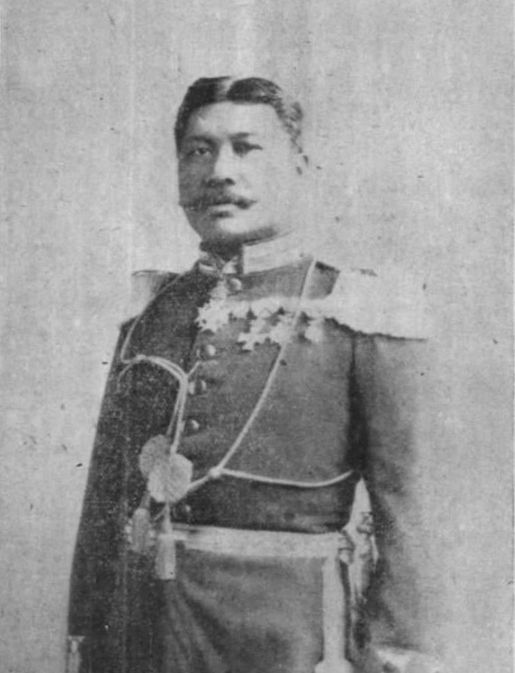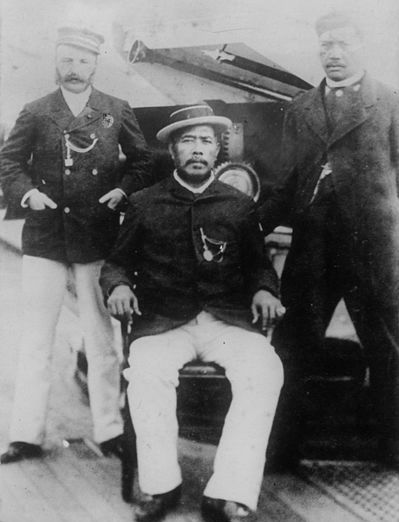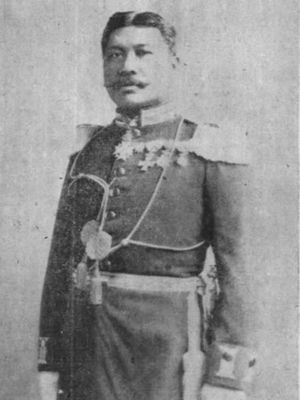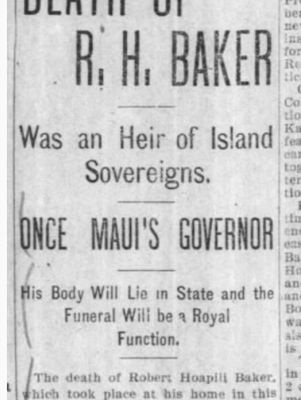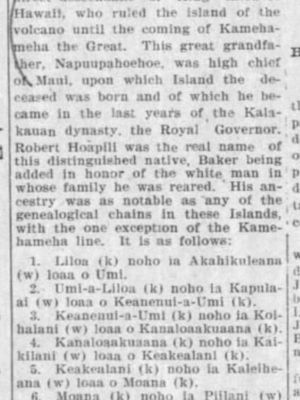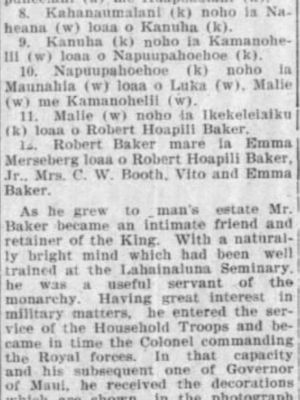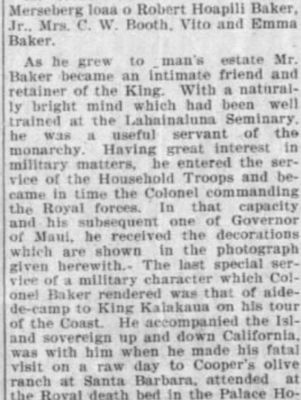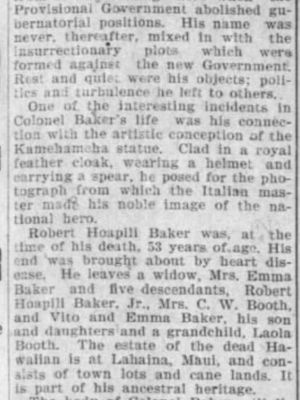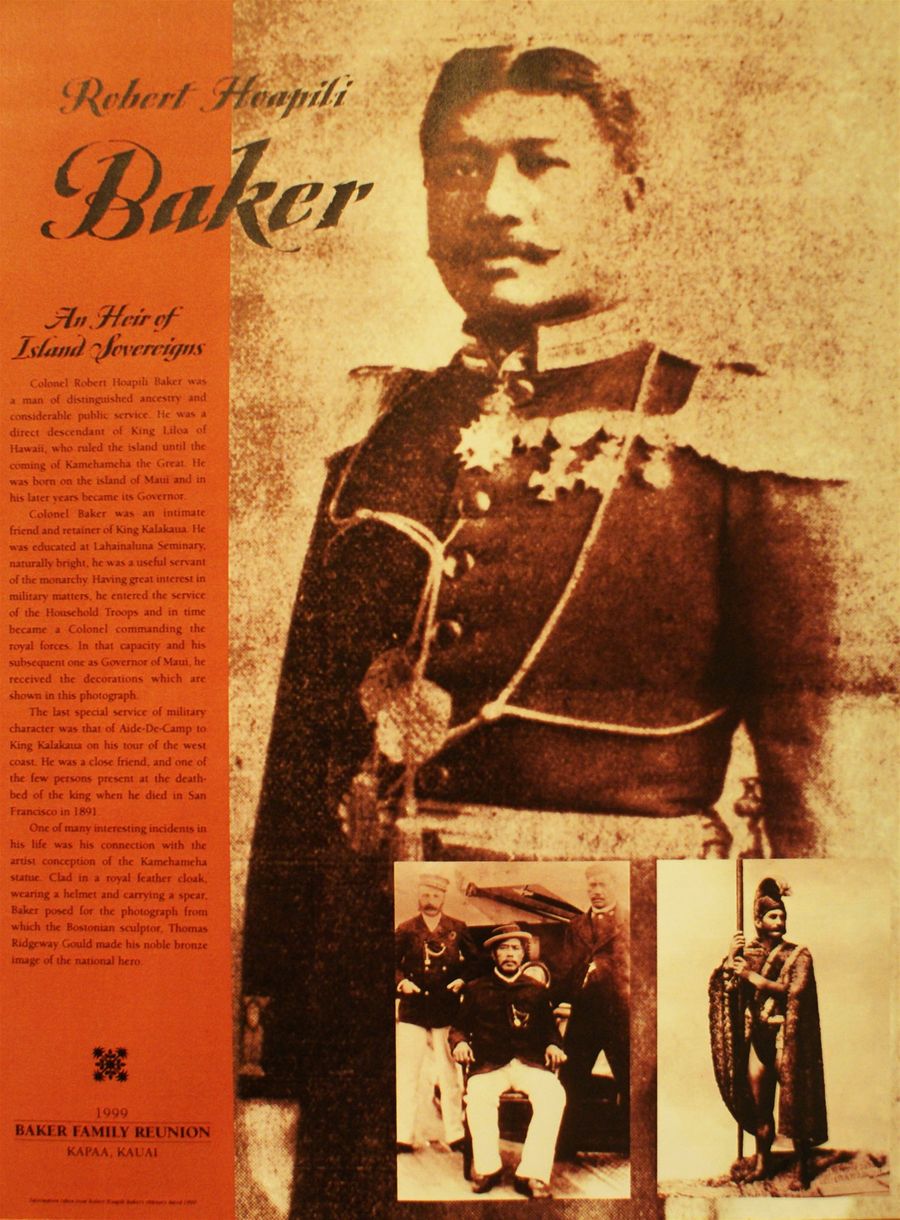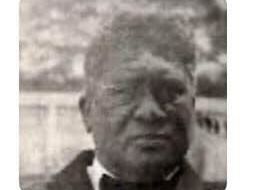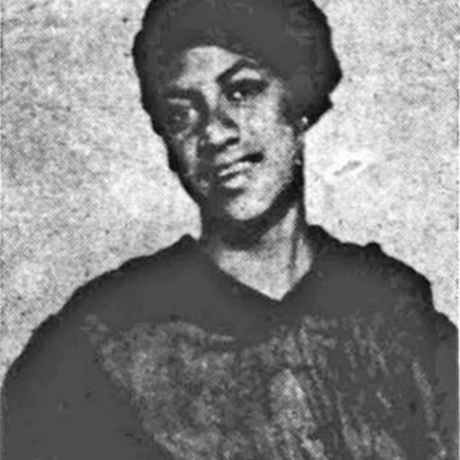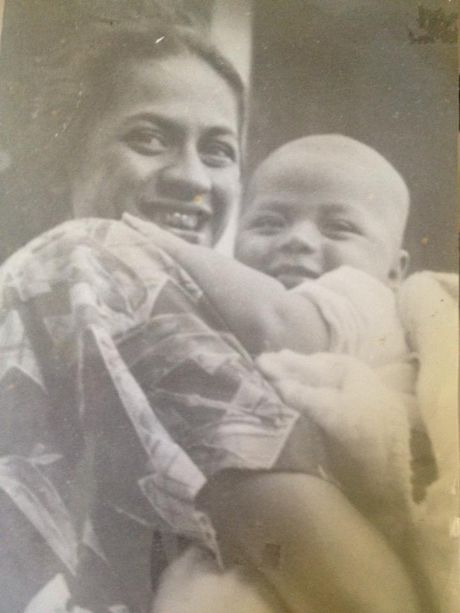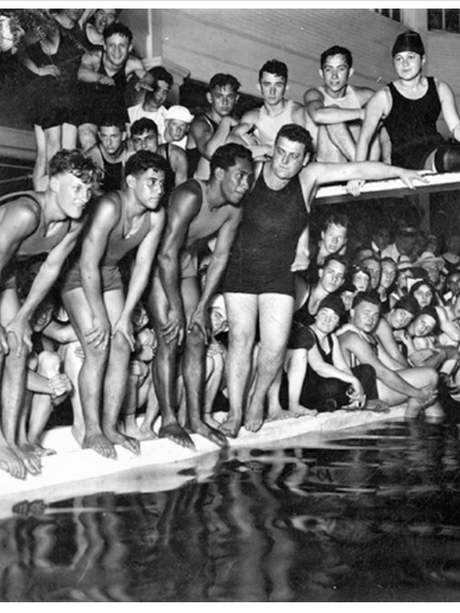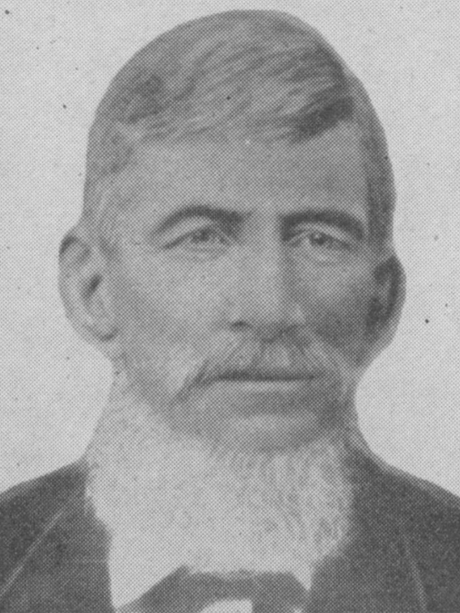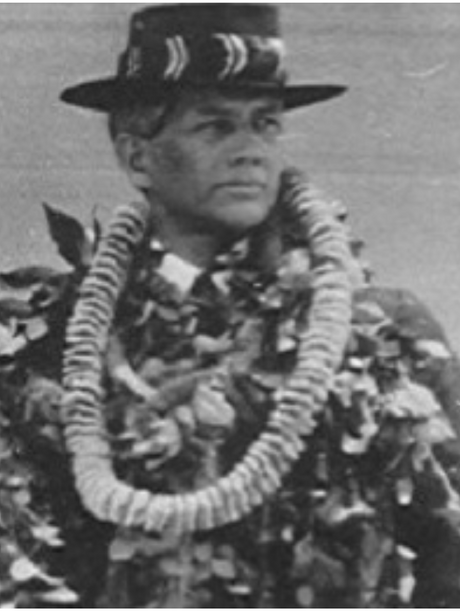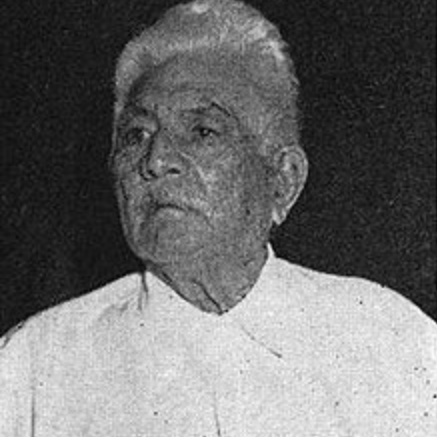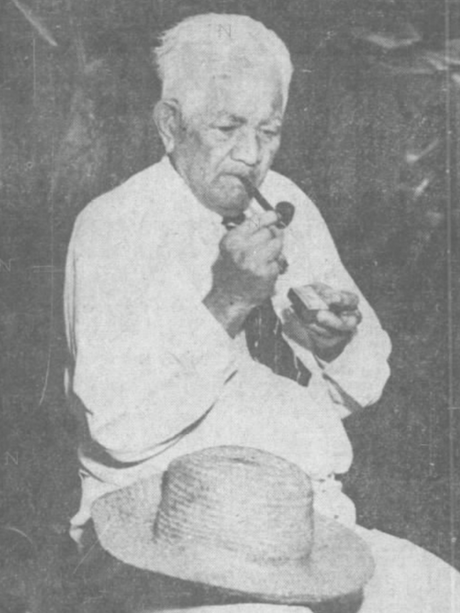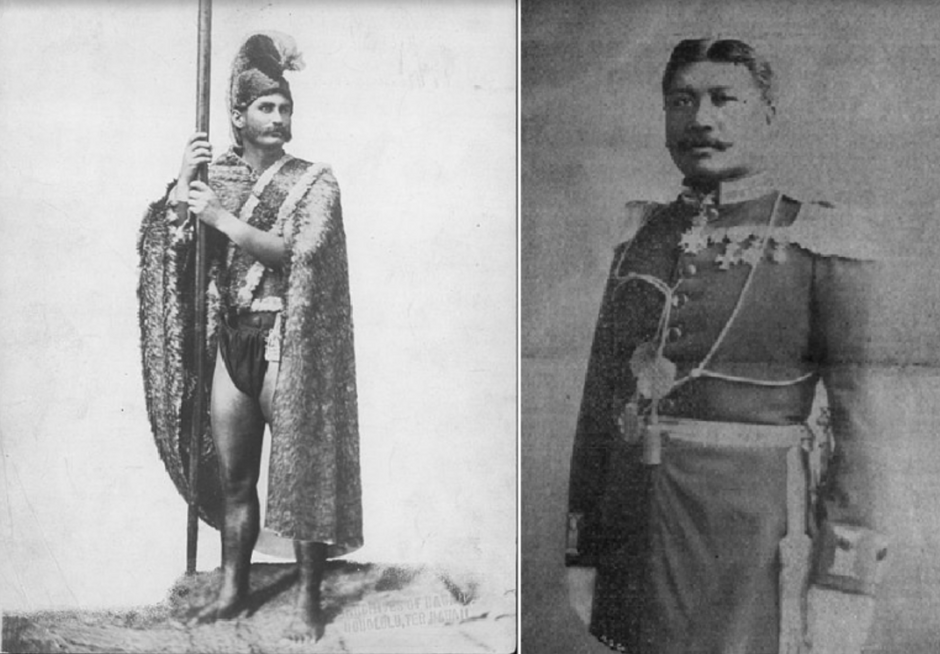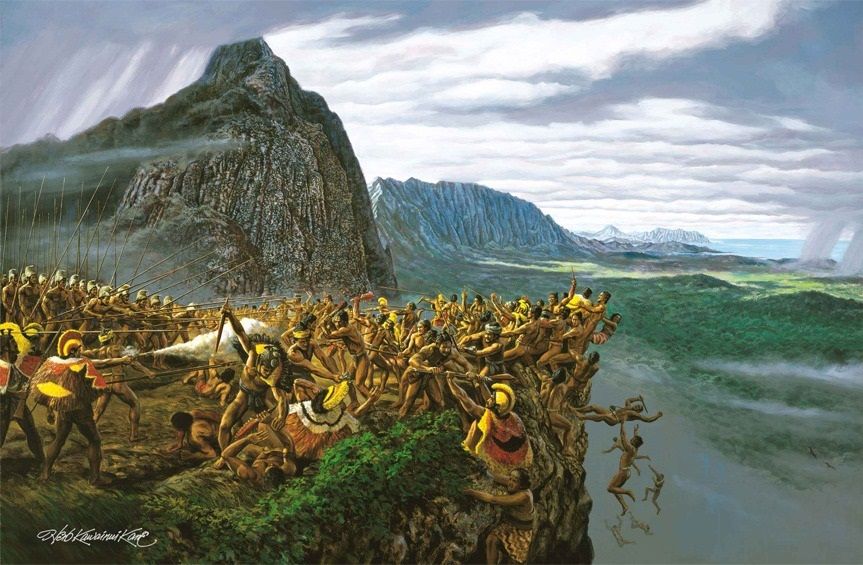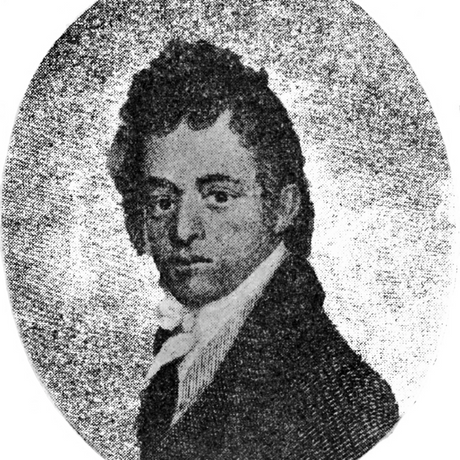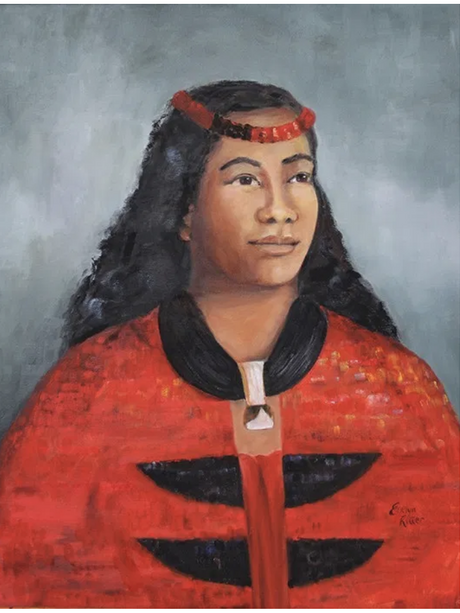Royal Legacy
Royal and Ali'i History of the Hoapili Baker Family
Prince Colonel Robert Hoapili Baker I
Prince Robert Hoapili Baker I at right (aged pictured is at rank of Major, then later became Colonel of the Royal Forces), cousin and royal aide-de-camp of King David Kalākaua. Colonel G. Macfarlane, at left. King David Kalākaua, at center, aboard the U.S.S. Charleston
The Royal House of Hawai'i – Ka Hale Ali'i O Hoapili Baker (Hawaiian translation for The Royal House of Hoapili Baker) is comprised of the Royal and Ali’i Hoapili Baker Family of Hawai’i. The royal surname of Hoapili Baker is readily associated with the last sovereign dynasty of the Kingdom of Hawai'i because of a High Ali'i of Royal birth, Prince Robert Hoapili Baker I, a prominent figure who lived during the lifetime of his cousins, King David Kalākaua and Queen Lydia Lili'u'okalani, and contributed significantly to the Kingdom of Hawai'i.
In Hawaiian nomenclature, the term "Ali'i" is the nearest and only equivalent for the European term, "Royal", however the Hawaiian term "Ali'i" was and is used in reference to various ranks of Ali'i leadership before and during the unification of the Hawaiian Islands into one Kingdom. For this reason, the Hoapili Baker Family prefers to be explicit in the definitive use of both terms "Royal" and "Ali'i", because the Hoapili Baker Family descend also from Royal lineages, that is to say, directly from ancestors who ruled during the final dynasty of Hawaiian Kingdom timelines, as corresponds to the European term of "Royal". Although the Royal Hoapili Baker Family have a long Ali'i lineage that is officially traced to the first recognized Mo'ī (the nearest equivalents in Hawaiian being, King, or Ruling Chief or Ruling Leader) of the Hawaiian Islands, Līloa of the island of Hawai'i, the dual surname Hoapili Baker originates from Prince Robert Hoapili Baker I. He was the eldest child of the Royal Prince Ikekeleaiku of the Royal Court of Kamakahelei, and High Ali'i Chiefess Maliekaihilani (aka Malie Kaikilani) Napu'upahoehoe, who, after the death of the Royal Prince Ikekeleaiku, later remarried a royally honored Captain of Oceanian waters named Adam C. Baker. Prince Robert Hoapili Baker I was the blood cousin appointed as primary royal aide-de-camp of King David Kalākaua, and his grandmother was the regnant Queen Kamakahelei of the independent kingdom of Kaua’i and Ni'ihau prior to the complete unification of the Hawaiian Islands.
Ikekele’aiku and Kaumuali’i were half-brothers through their Royal mother in common, Queen Regnant Kamakahelei of Kaua’i and Ni’ihau. From his birth in 1847, the eldest child and son of the Royal Prince Ikekele'aiku and High Ali’i Malie Kaikilani Napu’upahoehoe, Kekaipuka'ala Hoapili (christened with the first name Robert, and therefore known as Robert Hoapili), held the distinction of Prince. In his obituaries and royal ceremonies, Robert Hoapili Baker is referred to as an Heir of Island Sovereigns, firstly, due to his proven blood relation to the last sovereign dynasty––the dynasty of King Kalākaua and his sister Queen Lili’uokalani––and secondly, to his family’s blood relation to the Kamakahelei and Kamehameha Royal Dynasties.
High Ali’i Julia Kapi’olani, who later became Queen Consort to King David Kalākaua, was also Prince Robert’s second cousin by blood, and a direct descendant (great-granddaughter) of Queen Kamakahelei.
Along with the notable historical attribution of being asked by his cousin King David Kalākaua to pose for the famous, commissioned statue of King Kamehameha I (an honor which he shared with his step-brother–and cousin– H.E. John Tamatoa Baker), Prince Colonel Robert Hoapili Baker was also marked in history as having been King Kalākaua’s trusted advisor and is notable for legislating the king’s progressive vision of the Hawaiian Youths Abroad Program, and the only family member with King Kalākaua during the voyage which accompanied the king’s body back to Honolulu. Prince Robert Hoapili Baker was honored with the place of leading the procession and carrying King Kalākaua's crown and scepter from the 'Iolani Palace to Mauna 'Ala (the Royal Mausoleum) during the funeral march, indicating his familial status and importance to the Crown. His rank in the Royal Family of the last sovereign dynasty of Hawai'i, as following the line of his cousin, the Primary Sovereign, King Kalākaua, was most explicit when he honored international Royal ceremonial protocol by carrying the king's crown.
Along with many historical pre-unification ali’i lineages across the islands, the Hoapili Baker Family also have multiple royal ancestral lineages. The Hoapili Baker Family's multiple lineages of the rank of Royal heritage include:
• the last reigning sovereign dynasty of the unified Kingdom of Hawai'i, the Royal Kalākaua dynasty, by which the High Ali'i Hoapili Baker Family are legitimately of contemporary Royal rank, as Prince Robert Hoapili Baker I was cousin to the Primary Sovereign, King David Kalākaua, and his sister Queen Lydia Lili'uokalani, and the highest ranking Royal Ali'i in his time after the Primary Sovereign.
• the longest reigning independent sovereign kingdom of Kaua’i and Ni'ihau, the royal dynasty of the court of Queen Kamakahelei, from whom the Royal Hoapili Baker Family share descendance with their Kawananakoa cousins. The Kawananakoa family descend from the sister of the Queen Consort, Julia Kapi'olani, whose name was Victoria Kūhiō Kinoiki Kekaulike II, a High Ali'i (High Chiefess) who was known by Kekaulike II. Kekaulike II had three sons, the oldest was Edward Keli'iahonui, the second was David Kawananakoa, and the youngest was Jonah Kuhio Kalaniana'ole, known as the Pi'ikoi Brothers, who, after their parents died, were adopted by Kekaulike II's surviving sisters, Kapi'olani and Po'omaikalani. The three Pi'ikoi Brothers were not born as Princes but the accurate distinction of the ali'i rank that they were granted was the honorary stylization of H.H. by their uncle by marriage, King Kalākaua. (It was the king's niece--the daughter of his youngest sister, Princess Miriam Likelike--H.R.H. the Princess Victoria Ka'iulani, who was appointed the rank of the Crown Heir, being the blood relative of the Primary Sovereign, King Kalakaua).
The House of Kawananakoa is the other surviving ali'i family of Hawai'i associated with the last sovereign dynasty of the kingdom. Given that they constitute the descendants of the nephews of the Queen Consort, Julia Kapi'olani, the House of Kawananakoa is in the position of the side of the Consort.
• the first royal dynasty of the unified Kingdom of Hawai'i, the Kamehameha Dynasty;
• and a close blood relation to the Royal dynasties of Tahiti intersecting at the remote and sacred Tahitian island of Maupiti.
Ke ali'i Princess Idony Punahele Hoapili stands alongside the royal Hoapili Baker ceremonial ahu'ula (feather cloak), on display at the Queen Emma Summer Palace in Nu'uanu on the island of Oahu.
The Hoapili Baker royal ceremonial ahu'ula is centrally housed between two royal ceremonial ahu'ula that belonged to Queen Lydia Lili'u'okalani, cousin of Prince Colonel Robert Hoapili Baker I.
Natural hulu (feathers) are a traditional symbol of Hawaiian royalty. The Hawaiian royalty and nobility wore feather cloaks and capes for ceremonies and battle. Across Polynesia the colors 'ula'ula (red) and melemele (yellow) were associated with both gods and chiefs. In the Hawaiian Islands, however, yellow feathers were valuable, due to their scarcity. The 'ahu'ula is a carefully woven work of art made of the fine soft plumage of birds under the contour-feathers, especially under the wings, called the ē'ē feathers in Hawaiian.
The royal Hoapili Baker 'ahu'ula cloak is made of yellow, red and black ē'ē feathers of the o'o bird, the Hawaiian word for the Moho nobilis bird, and green parrot feathers.
Ke Ali'i Prince Colonel Robert Hoapili Baker I
Prince Robert Kekaipuka'ala Hoapili was born at Waikapu on the island of Maui, to High Chiefess Ali'i Malie Kaikilani Napu'upahoehoe, granddaughter of High Chief Ali'i Napu'upahoehoe of Maui, and to Prince Ikekeleaiku, son of Queen Kamakahelei of Kaua'i and High Chief Ali'i Kini.
As Prince Ikekeleaiku died when his children were young, his eldest son, Prince Robert Hoapili, included the surname of his stepfather, Captain Adam C. Baker, as an adjunct to his biological surname of Hoapili, in honor of Baker's paternal role and his guidance into the Hawaiian political arena.
Prince Robert Hoapili attended the Seminary in Lahaina, Maui, along with other children of ali'i of various ranks, as well as the children of American missionaries. It was the first boarding school in Hawai'i, and was built on land granted to Protestant missionaries by King Kauikeaouli (Kamehameha III), through the influence of High Ali'i Ulumāheihei Hoapili (another ancestor of the Royal and Ali'i Hoapili Baker ohana, who was a son of one of the royal twins, High Ali'i Kame'eiamoku). Motivated by the American Board of Commissioners for Foreign Missions to expand on a curriculum beyond the intentions of converting ali'i by private tutelage, the instructors sought to "civilize" the Kānaka Maoli with the aim to educate, convert and train them to fill positions as leaders in Hawai'i amidst the prevalently developing style of western government. When the independent school was transferred to the government in 1850, the Seminary had graduated over four hundred Kānaka Maoli who would wield a powerful influence on the political and social life of Hawai‘i. Some of the most prominent later historians, authors and politicians in Hawaiian society were among the first graduating classes at Seminary, including David Malo, Samuel Mānaiakalani Kamakau, and John Papa ‘Ī‘ī, who is also an ancestor of the Royal and Ali'i Hoapili Baker ohana. Prince Robert Hoapili excelled in political studies at Lahainaluna Seminary, a predilection which would serve him well later in life during his tenure as Royal Governor of Maui from 1886-1888, appointed by his cousin, King David Kalākaua.
Robert Hoapili Baker, or as he was best known during his lifetime, Hoapili Baker, developed strong military affinities from an early age, and he was for many years an officer in the Household Troops, for a time a Captain, and in time became the Colonel commanding the Royal Forces. As he was related by blood to Kalākaua, he was appointed the position of royal aide-de-camp of the King, his cousin, and also travelled abroad with Kalākaua.
This list identifies ke ali'i Robert Hoapili Baker I as a member of King Kalākaua's Privy Council from 1884 - 1891.
On February 15th, 1891, the funeral service for the last King of Hawai’i, King David Kalākaua, was held at 11 A.M. in the throne room of the ’Iolani Palace. The king had died on January 20th in San Francisco, California, and his body had lay in state in the ‘Iolani Palace for two weeks inside the throne room.
The king’s casket was placed on top of Nāhi'ena'ena's Pa'ū, an 'ahu'ula (royal feathered cloak) that had been worn by King Kamehameha III's sister, Princess Harrieta Keōpūolani Nāhi'ena'ena, with another ’ahu’ula draped across the casket cover. Twenty-four men of ali’i descendance each bore a Kahili stand and stood watch in rotating shifts, singing either the traditional mele (songs) and chants specific to the family of the deceased, or their own compositions during their vigils.
The Pacific Commercial Advertiser reported, "Not the least among the attractions to the Palace during the past two weeks was the singing by the native choirs in Iolani Palace, in the evenings, often till after midnight. The songs were mostly recent compositions in honor of the late King, and were sung either by a full choir of twenty or more voices, or as solos with a chorus from the choir."
The entire ceremonial service and its music was conducted the Hawaiian language. Crown Princess Lili’uokalani composed her own chant for the choirs, based on Psalm 90. In her memoirs, she noted her fascination of the women of the Hale Nauā Society and their prayer rituals over the body of King Kalākaua I. The King had inducted women into the Hale Nauā Society of intellectual and scientific advancement as equal members for the first time in Hawaiian history.
During the ceremonial funeral procession from the 'Iolani Palace to Mauna 'Ala, the Royal Mausoleum in Nu'uanu Valley, the king’s cousin by blood, Prince Robert Hoapili Baker I (at the time of the military rank of Colonel in the Royal Army), was honored with the place of leading the procession in front of his cousin's coffin, carrying his crown and scepter on a pillow, indicating his familial status and importance to the Crown. His step-brother (and cousin), H.E. John Tamatoa Baker, walked alongside him carrying the king's royal orders and jewels on a pillow.
Gowen described the ceremonial procession of February 15th, 1891.
“… slowly and solemnly the mournful cortege descended the steps of the palace and placed the mortal remains of their beloved monarch on the catafalque which was to bear him from their sight forever.”
“As the cortege entered the mausoleum a dirge was played on the organ. The committal service was then read by the Bishop, who, with the clergy, stood at the head of the coffin.”
“After the hymn the Hale Naua Society marched into the building to perform the ceremony of depositing the sacred Calabash on its late President’s casket.”
“At the close of the church service the United States marines outside performed the last military honors by firing-three volleys in the air.”
“Four large kahilis were fastened upright to the earth in front of the mausoleum, there to remain, according to ancient custom, till the last shred is blown away.”
“The Kalākaua emblematic torches were burning in front of the building throughout the ceremonies. Seven mammoth torches composed of tar-barrels were burning on the top of Punchbowl mountain during the funeral.”
It was said that King Kalākaua's funeral procession from the 'Iolani Palace to the Royal Mausoleum at Mauna 'Ala in Nu’uanu Valley was so long that it took seventy-five minutes to pass one point.
Sources: Peter T. Young’s https://imagesofoldhawaii.com/kalakaua-funeral/ ; Hawaii State Archives
This is an archive of mandatory documentation of one of the royal ancestors of the Hoapili Baker family of Hawai'i, Prince Robert Hoapili Baker I, taken for the National Registry of the Republic of Hawai'i in 1896, one of the earliest occurences of finger-printing in Hawai'i following the Kaua Kūloko (Civil War) of January 1895.
Following the forced overthrow of King David Kalākaua's sister, Queen Lydia Lili'uokalani in 1893, the Committee of Safety, a thirteen-member group known as the "Annexation Club" whose purpose was to overthrow the remnants of the Hawaiian government, established the American Provisional Government of Hawai'i as a temporary government until an assumed annexation by the United States could be put fully into effect.
Following the January 1895 Kaua Kūloko that sought to topple the government of the Republic of Hawai'i, the Provisional Government introduced the regulation of registering the identification of males living in Honolulu, and especially males of royal bloodlines. Prince Robert Hoapili Baker I, at age 48, indicated on his registration that his address was in Waikapu, on the island of Maui.
The information in the following historical American articles, as well as on the poster created in 1999 by members of the Royal Hoapili Baker ohana, about the man whom the Hoapili Baker ohana refers to as "Papa Ali'i" owing to the origin of their altered surname, was expanded upon when an in-depth investigative research was conducted over the course of six months in 2018 by Hawaiian genealogical expert Douglas Po'oloa Tolentino, by the invitation of Hawaiian cultural and historical expert Herman 'Helemano' Lee.
Robert Hoapili Baker I's royal lineages and princely title used during his lifetime are also indicated in the obituaries of several Hawaiian newspapers, including the attribution to his bloodline legitimacy as an "Heir" of sovereigns. The Pacific Commercial Advertiser ran the article shown directly below on April 6, 1900, which was researched and included in a publication created by the Rosa and Kekauoha families of the Ke Ali'i Libby Kahalewehi (Baker) Mendonca branch of the Hoapili Baker family specifically for a Hoapili Baker family reunion in 2007.
The Pacific Commercial Advertiser ran the above article on April 10th, 1900. Due to the quality of the old image, please see the transcription of the text below.
"The funeral of Robert Hoapili Baker, which took place Sunday afternoon at Mililani Hall, was marked by solemn and impressive ceremonies. One of the very last of a Royal Hawaiian line, the deceased was laid to rest with every token of respect and grief. About his bier while the body lay in state for two hours gathered the people who love the legends of a fast-dying race. Tears that were shed for the passing away of a noble descendant of mighty chiefs were dropped with a thought for the glory that had gone forever. Women were not wanting to lay the wreath of sad and loving regard upon the coffin, and men who had known Robert Hoapili Baker in life mourned him dead with a sincerity apparent in word and demeanor."
1
2
3
4
5
6
Poster created by members of the Royal Hoapili Baker ohana in 1999
Ke Ali'i Robert Hoapili Baker II
Ke Ali'i Robert Hoapili Baker II was born July 15, 1874. He was the son of Prince Colonel Robert Hoapili Baker, Royal Governor of Mau'i and aide-de camp to his cousin King Kalākaua. His mother was Ali'i (Chiefess) 'Emma' Kamakanoanoa Merseberg. His great-grandmother was Queen regnant Kamakahelei of Kaua'i.
Ali'i Emma's father was William Merseberg, who served as the third Bandmaster of the King's Band (1848-1870), and her mother was Ali'i High Chiefess Kealii Kamakanoanoa Kanaihalau of the Ali'i House of Kohala. The birth of ke ali'i Robert Hoapili Baker II, generated another union of the Royal Houses of Kamakahelei, Moana, Liloa and Kohala, in addition to their unifying lineal descent.
Ke Ali'i Robert Kahakumakalima Hoapili Baker II
When ke ali'i Robert Hoapili Baker II married ke ali'i Elizabeth 'Libby' Lokai Kahalewehi Komoika'ehuehu of the Ali'i House of Luluka, that propitious marriage brought about the union of the House of Luluka, guardians of King Kamehameha I, and the Hoapili Baker family of the combined ali’i lineage of the Houses of Kalākaua, Kamehameha, Kohala, Moana (kane) and Līloa.
Libby Komoika'ehuehu's father, John Komoika'ehuehu, was a lawyer and legislator, as well as a land owner, rancher, fisherman and taro planter. Like her husband's father, Prince Colonel Robert Hoapili Baker I, Libby Komoika'ehuehu was also the direct descendant of the Mo'ī King Keakealani of the island of Hawaii, and to High Ali'i Chief Nahi'ole'a.
Ke ali'i Robert Hoapili Baker II and his wife ke ali'i Libby Komoika'ehuehu raised their children in Pawa'a, South King Street and Kalākaua Avenue, on the island of Oahu, on property of the estate of John Papa I'ī', whose uncle was High Ali'i Chief Nahi'o'le'a. They had four children, ke ali'i Robert Hoapili Baker III, ke ali'i Vito 'Veto', and two daughters, ke ali'i Elizabeth Kahalelaukoa and ke ali'i Emma.
Sunday was always a church day, the family attended the Kikipi Congregational Church then located off South King Street, where both Ke ali'i Robert and Libby were ordained as ministers. On Tuesdays, the Reverand Kikipi taught classes of Hawaiian Language and History for the families who were members; this is where Robert and his siblings learned their ABC's in Hawaiian.
Soon after the group of American businessmen overthrew Queen Lili'u'okalani, she issued the edict that the Hawaiian Language was forbidden to be spoken. This was partly to protect Hawaiians from the threat of an implemented penalty of arrest if Hawaiians were heard speaking their native language, but for ali'i families, the penalty was death. Ke ali'i Libby Komoika'ehuehu Baker respected the queen's edict in earnest, and only allowed their children to learn their Hawaiian language where there was no threat of scrutiny at church.
Ke ali'i Robert Hoapili Baker II also followed in his grandfather William Merseberg's footsteps and became the eigth Bandmaster of what is now known as the Royal Hawaiian Band from 1917–1920, and conducted orchestral rehearsals and performances at the Opera House on King Street across from the 'Iolani Palace.
Ke Ali'i Robert Hoapili Baker III
Ke Ali'i Robert Hoapili Baker III was born in the year 1900 on King David Kalākaua's birthday, November 16th. He grew up in Pawa'a, Honolulu on property owned by the estate of John Papa I'ī. He often accompanied his father to the Opera House which was across the 'Iolani Palace, during his father's orchestral rehearsals with the Royal Hawaiian Band. At 10 years old, he was enrolled in the Kamehameha Preparatory School on North King Street, which included an extensive curriculum in the manual trades as well as full scale military training at Makua Beach. He excelled in musical studies, enjoyed playing the guitar, ukulele and mandolin, and began his musical career playing at school dances.
After his education at the Kamehameha Preparatory boarding school, ke ali'i Robert embarked on his professional music career. Interested in performing music, he joined the Ernest Ka'ai Glee Club managed by Mr. Henry Bishaw, and immediately began playing with the group professionally in the Honolulu tourism industry, most often at the Seaside Hotel and the Moana Hotel. He travelled with Bishaw's group to the West Coast of the United States, as well as to Tahiti, Fiji, New Zealand, Australia and to other countries in Oceania, touring for seven months at a time in conjunction with ships unloading cargo en route.
In 1918 Robert joined his father in the Royal Hawaiian Band, much to the pleasure of his parents, performing in the Opera House and at outdoor special events; his orchestral instrument was the valve trombone, while his father, Ke Ali'i Robert Hoapili Baker II, was the Bandmaster conductor. About that time, he met the girl who later became his wife––Bernicia Ka'iliponi Lane, daughter of Mr. and Mrs. Lot Lonoikaua Kamehameha Carey Lane of Honolulu, of the affluent ali'i Hawaiian-Irish Lane family who effected positive economic impact and had owned vast swathes of land on Oahu before it was appropriated by the American Provisional Government at the time of the annexation of the Kingdom. Bernicia had already developed a stellar reputation for herself as a champion competitive swimmer who toured internationally with her cousin, Clarence Lane, and close family friend, the legendary surfer Duke Kahanamoku, who were swiming teammates.
Robert made up his mind to follow the Lane family to Hilo, Hawaii in 1919, after Bernicia moved with her parents and siblings to become involved with the new Waiakea Homestead ventures that were developping there.
Ke Ali'i Bernicia Ka'iliponi (Lane) Baker (1898 - 1941)
Preparations were made for the uniting of two souls, and Robert and Bernicia were married in Hilo in late summer of 1919, where they remained. Together they had eight sons and five daughters, all born in Hilo.
After a position at the Matson Navigation Company inspecting incoming freight, Robert was appointed the position of Chief Inspector for the Board of Health, Hilo branch. He worked for several years as the City Inspector, Sanitation, before being promoted to Quarantine Officer for the island of Hawai'i.
During the 1930s, the United States Public Health Service was probing Dr. F. E. Trotter, then the department supervisor of rodent control activities and communicable diseases, especially in the preparation and distribution of rodent poison baits on the island of Maui. Robert was assigned to that position of Field Supervisor at the project's site at the vacated Haiku Dairy Farm in Haiku. Labor was furnished by the UPW workers for the preparation of all mixes of poison baits and making torpedoes. When the important operation was in full swing, Robert and the crew of Rodent Control and UPW laborers were able to distribute and broadcast over a million torpedoes each month; the project lasted eight months, after which Robert returned to his position as Quarantine Officer for the island of Hawaii.
Always acting as Liaison Officer between the Administrating Officer in charge of the Department of Health and the Medical Doctors and Practioners, ke ali'i Robert investigated all cases of reported communicable diseases, assisted in mass-immunization clinics, and followed-up on laboratory results whether positive or suspicious.
Despite a successful operation in 1939 after ke ali'i Bernicia Ka'iliponi complained of feeling ill, she entered hospital again in 1941 and passed away. In 1943 rodent plague cases and also human plague cases were being reported; Robert completed his investigative records and reports as Quarantine Officer and moved residence with his children to Hamakua, where he was given plague immunization treatments and took on the Rodent Control Program as Supervisor. Robert had at his disposal a laboratory with around 200 cages of guinea pigs for inoculation purposes, to help determine the presence or absence of the plague bacilli; positive culture tests were necessary before a case could be recognized.
The eldest of ke ali'i Robert and Bernicia's offspring moved to other islands and started their own families, while the youngest benefited from being partially raised by their ali'i kahu (priestess) grandmother, ke ali'i Libby Komoikaehuehu, both an ordained Christian minister and a powerful Hawaiian kahuna (expert). In 1948, ke ali'i Robert married his second wife, Mary Dias of immigrated Portuguese descent, who then bore him two more children, ke ali'i Robert James Baker and Samuel Arthur Baker. They later remarried in Honoka'a Catholic Church, where the children were altar boys.
Ke ali'i Robert Hoapili Baker III spent his retired years enjoying off-shore fishing with his children and was an avid horticulturalist tending to his large orchid nursery. His award-winning orchids were renowned and he was honored for cultivating two new species and given the distinction of assigning scientific names to each for posterity. He also cultivated roses, bromeliads and other native species.
Content taken from the autobiography that ke ali'i Robert Hoapili Baker III dictated to his eldest grandchild, Elizabeth Pualani (née Kuali'i) Wessel.
The content of this article is privately owned under the Royal House of Hawai'i - Ka Hale Ali’i O Hoapili Baker and ke ali'i George Ī’i Baker, of the Royal Hoapili Baker ohana, Hawaii. This article may not be reproduced or used again on another internet page or platform.
Ke Ali'i Bernicia Ka'iliponi (Lane) Baker with infant daughter Ke Ali'i Bernicia Ka'iliponi Baker (later Carreira)
American Red Cross Benefit Swimming Meet at Brighton Beach, New York. The Hawaiian swimmers from left to right: Harold Kruger, Clarence Lane, Duke Kahanamoku and starter Elionsky.
Ke Ali'i Bernicia Ka'iliponi (née Lane) Baker
Ke Ali'i Bernicia Ka'iliponi (née Lane) Baker, mother of thirteen na keiki ali'i (royal or ali'i children) of Robert Hoapili Baker III––including ke ali'i HRH George I'i––and great-grandmother of ke ali'i HRH Idony Punahele Hoapili, was a champion internationally competitive swimmer who toured with a friend of her family, the legendary Duke Kahanamoku.
Her cousin was international swim titleholder Clarence Lane, a teammate of Duke Kahanamoku and Harold Kruger.
The three young swimming champions, Lane, Kahanamoku and Kruger toured the continental United States and regions in Canada, including military bases, promoting swimming, diving and lifesaving together at fundraising events to benefit the war effort.
They also took the opportunity to play ukulele and sang at benefit events spreading 'Aloha'.
Also see the article in The New York Times of January 4th, 1917:
Lane Ohana
The lineage and family of Ke Ali'i Bernicia Ka'iliponi (Lane) Baker
The Lanes of Hawai'i were avowed Royalists. Queen Lili'uokalani personally selected the towering and handsome ali'i Irish-Hawaiian brothers Lot Lonoikaua Kamehameha Carey Lane, John Awena-ika-lani-keahi-o-ka-lua-o-Pele Carey Lane and James Lane, sons of the prosperous Oahu rancher and Legislator, William Carey Lane, to be her personal guard at 'Iolani Palace.
William Carey Lane
William Carey Lane's father was said to be a descendant of Irish kings. Lane's father, a devout Catholic, had forfeited his estate lands in Ireland and moved to New York, taking his son William with him.
William Carey Lane had been an Irish sea Captain who emigrated to the Hawaiian Kingdom and married a Hawaiian Ali'i Chiefess by the name of Mary Kukeakalani Kahooilimoku (Kukeakalanihoilimoku), whose family was from a sacred kahu (priestly) lineage related to the royal family of Kamehameha.
In fact, Kukeakalani was the daughter of Ali'i Kukanaloa, a member of King Kamehameha I's court who served as the keeper of the kings' personal wa'a peleleu (double hulled war canoe).
The entrance of the Irishman William Carey Lane pinpoints the first convergence of Hawaiian and foreign blood in the ancestral Hawaiian heritage of the royal and ali'i Hoapili Baker 'ohana.
William Carey Lane had the greatest respect for his beloved wife's ali'i Hawaiian heritage, and together they produced ten children. The Lane family had cultivated a long and fiercely loyal connection with the Hawaiian monarchy.
William Carey Lane (1821 - 1895)
The following images are extracts from a publication lovingly arranged by the Rosa and Kekauoha families of the branch of Ke Ali'i Libby Kahalewehi (Baker) Mendonca of the Hoapili Baker family, which they had especially researched in honor of a joint family reunion of the Hoapili Baker 'ohana and their Lane 'ohana cousins held in 2007. The content of the article was graciously submitted by Melanie (Lane) Grimm of Maui. The original images are located at the Bishop Museum Archives.
The family publication mentions the origins of William Carey Lane, who came to the Hawaiian Kingdom from Cork in Ireland and fell in love with and married a Hawaiian Ali'i Chiefess having twelve children together, and about his dynamic legacy in Hawai'i.
Ali'i John Awenaikalanikeahiokaluaopele Carey Lane (1872 - 1958)
Ali'i John Awenaikalanikeahiokaluaopele Carey Lane
John Awena-ika-lani-keahi-o-ka-lua-o-Pele Carey Lane, the great-uncle of H.R.H. Prince George I'i Baker and twelve of his siblings, was born on July 22nd in 1872 at Makao, on the island of Oahu, to Ko'olau Ali'i Chiefess Kukeakalanihoilimoku, whose family was from a kahu (priestly) lineage related to the Kamehameha family, and an Irish sea Captain, William Carey Lane, who became an integral figure in the Hawaiian Legislature. Ali'i John C. Lane was the brother of ali'i James Lane and the famous rebellion figurehead ali'i Lot Lonoikaua Kamehameha Carey Lane.
Ali'i John Carey Lane was educated at Hauula School and at St. Louis College. He held various jobs as a clerk, and from 1893 to 1900 he farmed on his father's ranch near Honolulu. The Lane family had been given a massive swathe of land on Oahu, mostly encompassing the Honolulu region. Ali'i John married Alice Kia Nāhaolelua. He served in the Hawai'i Senate from the 3rd district, in office between 1905-1907, and as the second Mayor of Honolulu from 1914 to 1917, and also had the office of High Sheriff of Hawai'i.
As well as holding the distinct honor of 'Ali'i Aimoku' of the Order of Kamehameha I, ali'i Mayor John C. Lane was also a Trustee of the Pan-Pacific Union. He was also a member of the Chiefs of Hawai'i, the Native Sons of Hawai'i, Court Lunalilo, No. 6600, A.O.F., the Phoenix Lodge and the Honolulu Advertiser Club.
Ali'i Mayor John Carey Lane was at Queen Lili'uokalani's side when, taking advantage of the vulnerability of the Kingdom of Hawai'i, the coup d'etat organized by American entrepreneurs and American Provisional Government officers led by Lorin Thurston was put into effect to overthrow the Hawaiian Monarchy. Ali'i John Awenaikalanikeahiokaluaopele Carey Lane lived until the 8th of February 1958 having reached 85 years of age.
Ali'i Lot Lonoikaua Kamehameha Carey Lane
The famous rebel Ali'i Lot Lonoikaua Kamehameha Carey Lane is the maternal grandfather of HRH Prince George I'i Baker and twelve of his ali'i siblings, and the father of ke ali'i Bernicia Ka'iliponi (Lane) Baker. He was born in Waialua on the 31st of July in 1864 to Ko'olau Ali'i Chiefess Mary Kukeakalani Kahooilimoku (Kukeakalanihoilimoku), whose ali'i family were direct descendants of a sacred kahu (priestly) lineage related to the royal Kamehameha family.
Among the courageous 400 people, both Hawaiians and non-Hawaiians, who took up arms against the regime of the Republic of Hawaiʻi in an attempt to restore former Ali'i Nui Liliʻuokalani to the throne, the man who struck the most fear into the heart of the Republic forces was an Irish-Hawaiian ali'i ancestor of the Hoapili Baker 'ohana named Lot Lonoikaua Kamehameha Carey Lane. Standing an imposing 6’4” with flashing eyes and a formidable demeanor, Lot was called by the Hawaiian Star newspaper “the finest physical specimen in the islands.”
In 1864, the newborn Lane son whose birth occured during the second year of the regime of King Kamehameha V, was given the name Lot Kamehameha by Lot Kapuāiwa––the Ali'i Nui Kamehameha V himself. The king threw a baby lūʻau in honor of his namesake, and invited more than 2,000 people to the feast.
In the 1880s, when Kalākaua had ascended the throne causing a rumble of unrest among the foreign powers in the kingdom, a young Lot Lane organized a force of 75 other young, tough country boys to act as a personal guard for the Mōʻī. When things quieted down, Kalākaua deployed the force back out to the kuaʻāina (country), but Lot Lane stayed on at court.
Ali'i Lot Lonoikaua Kamehameha Carey Lane (circa 1948)
A profound aloha ʻāina (love of their land) compelled the Lane family, and after King Kalākaua’s death, Lot and his brothers John and James were personally selected to be among the members of Liliʻuokalani’s personal guard. When they heard rumblings about the 1895 counter-revolt to restore their beloved queen, the patriarch of the family William called his sons together and bade them, “Go, my sons. Go forth and fight for your mother’s land. Spill your blood on the soil of your homeland if need be.”
The fact that Lot Lane took up a leading stance with his rebellious countrymen to battle against the beginnings of the regime of the Republic shouldn't be surprising, his Irish father was the Oahu rancher and Legislator, William Carey Lane, whose family came from Cork County in Ireland, also known as “The Rebel County.”
The Lane boys joined the rebel forces whose ranks had been supplied with nearly 300 repeating Winchester rifles, 100 pistols and 30,000 rounds of ammunition sent from San Francisco. Despite that there were only 400 rebels, they stood firm against the better-equipped and much larger forces of the Republic. Their plan had been to assemble at Lēʻahi (Diamond Head), and then proceed to capture strategic government buildings, but spies and circumstance meant that the plan was sprung into place before it was ready. Even though these brave warriors fought valiantly in the Battles of Mōʻiliʻili and Mānoa, they were finally defeated and all the leadership captured, save for Lane.
Lot Lane was the last warrior of the rebellion captured by the Republic, surviving in the hills of Mānoa on rainwater and wild bananas, emerging from cover only because he thought that the foreign aid promised his rebels had finally arrived.
Ali'i Lot Lonoikaua Kamehameha Carey Lane (1864–1953)
Upon discovering that Queen Liliʻuokalani had been arrested, Lane turned himself in and was accompanied to his cell by six Republic soldiers armed with rifles, a testament to the fear this massive kanaka struck in their hearts. Seeing more than a hundred of his compatriots malnourished and suffering in the prison, the first thing that Lane did was use his intimidating stature to parlay and secure their better treatment. He employed creative tactics of striking up an unrelenting clamor by clanging his metal food tray against the cell bars and roaring until the guards came and quietly capitulated to his demands.
Ten days after the beginning of the counter-revolt, Lot Lane surrendered peacefully by turning himself in. When put on trial, he refused counsel, insisting that he wanted to look at his accusers right in the eyes, “not for shame to me but to shame them.” It is documented that when Lot Lane was accused as an insurgent for the charge of Treason, he retorted, “You say I am a traitor. Traitor to whom? To my country? To my queen? No! I say that you are the traitors. Traitors to the land that gave you aloha.” He was later acquitted of his charges of Treason.
The youngest keiki (children) of ke ali'i Lillian Kalani (Baker) Naihe (the youngest child of ke ali'i Robert Hoapili Baker III and ke ali'i Bernicia Ka'iliponi (Lane) Baker, and the sister of HRH Prince George I'i Baker), are twins of formidable stature––6'9" ke ali'i Hanalei and 6'7" ke ali'i Kamu'ela––who were both given the middle names of Carey Lane in honor of the Irish-Hawaiian maternal great-grandfather Lot Lonoikaua Kamehameha Carey Lane and his brothers, among the multiple ali'i heritages of the Hoapili Baker 'ohana.
Sources:
• Genealogies of Kalākaua and Kapi'olani by Mayor John C. Lane
• Article post on the Facebook page, 'Kanaeokana', January 27, 2020, about Lot Lonoikaua Kamehameha Carey Lane
• Wiki Visually page: https://wikivisually.com/wiki/John_C._Lane
Article in HAWAI'I MAGAZINE about the stepbrothers H.E. John Timoteo Baker and Prince Colonel Robert Hoapili Baker I
At left, John Timoteo Baker modeling for the Kamehameha statue. At right, Prince Colonel Robert Hoapili Baker, royal governor of Maui. Photos from the Hawaii State Archives
The two Hawaiian brothers who modeled for the iconic Kamehameha statue
John Timoteo Baker and Robert Hoapili Baker modeled for the statues you see today on O'ahu island, Hawai'i Island and at the Pentagon in Washington D.C. BY MATTHEW DEKNEEF JUN 10, 2016
Upon uniting the Hawaiian Islands in 1810, Kamehameha I laid the foundation for a strong monarchical tradition and through his governance reestablish peace and restore the economic climate of the Islands previously ravaged by civil wars. Kamehameha is credited for cultivating overseas trade and interfacing with nations outside Hawai'i, but he’s also remembered for instituting laws that preserved the land’s natural resources, from prohibiting overfishing to regulating how much sandalwood could be cut from forests throughout the century.
Saturday, June 11, is Kamehameha Day, a state holiday that celebrates these achievements and foresight. An iconic statue in Honolulu—Hawaii’s most photographed work of public art—memorializing this legendary figure of Polynesia has a fascinating backstory, as recounted in the book, “The Arts of Kingship: Hawaiian Art and National Culture of the Kalākaua Era” by Stacy L. Kamehiro.
Its inception and construction reveals a lot about the Kingdom of Hawai'i at the time, then ruled by King Kalākaua, whose government motto of “Ho'oulu Lahui” (“Increase the Nation”) was meant to instill pride in Hawai'i’s people and Native Hawaiian culture as its government became a more prominent entity among the world’s economic players. Until Hawai'i was forcibly annexed in 1898 by the United States, the Hawaiian Islands were an independent nation that participated in global trade, had its own currency, postage, library and museum systems, achieved near universal literacy among its citizens and thrived despite imperialistic threats throughout the 19th century.
In the face of all this modernity and new international standing, Kalākaua and his appointed Prime Minister Walter M. Gibson deemed it that much more important to commemorate Hawaii’s past by memorializing it with a permanent, public monument: The King Kamehameha statue.
In his proposal for artistic statue of Kamehameha over a lighthouse or government building, Gibson said:
“Some would appreciate a utilitarian monument … and I highly appreciate the utilitarian view, yet I am inclined to favor a work of art. And what is the most notable event, and character, apart from discovery, in this century, for Hawaiians to commemorate? What else but the consolidation of the archipelago by the hero Kamehameha? The warrior chief of Kohala towers far above any other one of his race in all Oceanica [sic]. His character, in view of his remarkable situation will ere long largely command the attention of thoughtful and noble minds of all lands. The appreciation of his character I hope to promote with my feeble pen; and his fame will be praised as a proud memento for Hawaii. Therefore let Hawaiians, especially you Hawaiian Nobles and Representative, lift up your hero before the eyes of the people, not only in story, but in everlasting bronze. Thus enlightened nations commemorate their heroes and good men.”
Gibson sought a classically trained sculptor, Thomas R. Gould, believing that fashioning the statue within the authority of the Euro-American academic tradition would attract the admiration of the world’s nations. That said, the iconography of Kamehameha is unequivocally rooted in Hawaiian history and culture. For Kalākaua and his advisors it was paramount to assert that the hero of the century of this land was not a foreigner, but a Native Hawaiian. That Hawaii’s most celebrated public figure for the rest of the world would be kanaka maoli (Native Hawaiian) and not, for instance, Captain Cook. The statue may be utilizing Western visual language, but the narrative it expresses is intentionally not: It is Hawaiian.
Authenticity was a priority for the statue’s design with Kalākaua and Gibson directly involved in the preliminary stages of it. Kalākaua personally provided sketches and suggestions for the musculature of the body, in addition to drawings and photographs of Hawaiian spears and a watercolor portrait Kamehameha sat for just three years before his death.
John Timoteo Baker poses (date unknown) alongside the finished Kamehameha statue, "The Conqueror." Photo at left, courtesy Hawaii State Archives. Photo at right, by Prayitno/cc.
To aid the artistic process, the Monument Committee sent photographs of Hawaiian men who fit their representation of what was believed to be Kamehameha’s admirable physique. They also included photographs of John Timoteo (a.k.a Tamatoa) Baker, the last royal governor of Hawaii, fitted in royal adornments to help realize the statue’s royal ahu'ula (feather cape), mahi'ole (helmet) and its rare ka'ai (feather sash).
The image above at left is known to be a composite image. From the torso up is H.E. John Tamatoa (a.k.a. Timoteo) Baker; from the torso down is Baker’s step-brother (and cousin) Prince Robert Hoapili, who had the more athletic physique. Prince Robert Hoapili Baker I served as aide-de-camp to King Kalākaua and later Royal Governor of Maui from 1886 to 1888.
The two brothers served as the chief models for the statue you see today on in downtown Honolulu on Oahau, on Hawai'i Island and in Washington D.C. and these photos serve as a reminder of the intensive and thoughtful process behind the now internationally recognized symbol of Kamehameha the Great.
Watercolor depiction of the High Ali'i, Ulumāheihei Hoapili, by Clarissa Chapman Armstrong
High Ali'i Ulumāheihei Hoapili
This is an in-depth account compiled from pre-existing texts about one of the ancestors of the Hoapili Baker ohana, Ulumāheihei Hoapili, son of one of the 'royal twins', High Ali'i Kame'eiamoku, and brother of Ali'i Kepo'okalani.
High Ali'i Ulumāheihei Hoapili (c. 1775 – January 3, 1840) was born during the reign of King Kalaniʻōpuʻu, Mo'ī of the island of Hawai'i, into the High Ali'i (Chief) rank of the nobility of Hawai'i and then later married a Hawaiian queen, an ancestor of the Hoapili Baker ohana, Keopuolani, during the formation of the Kingdom of Hawaii. In his youth Ulumāheihei was an athlete, standing about 6.5 feet (2.0 m) tall, and robust with strong arms, light clear skin, a large high nose, eyes dark against his cheeks, his body well built, altogether a handsome man. A story was told of how he once wrestled down an attacking bull by its horns.
Hoapili's father was High Ali'i Kame'eiamoku, known as one of the "royal twins" who helped Kamehameha I come to power. After Kame'eiamoku's death, Hoapili inherited his father's counselor position in Kamehameha's court.
He became a very close friend and a trusted military and political advisor to King Kamehameha I. He became known as hoa pili which means "close personal friend" in the Hawaiian language because of his trusted relationship with Kamehameha. An extant saying was "O Ulu-maheihei wale no, ia ia oloko, ia ia owaho", translating roughly to "Ulumāheihei knows everything inside and out." A few years after the famous battle of Nuʻuanu of 1795 when Kamehameha conquered Oʻahu and Maui, Hoapili was left in charge of the island of Oʻahu and the royal court settled at Kamakahonu in present-day Kailua-Kona.
A painting of the famous Nu'uanu Battle by artist Herb Kane
Hoapili's first marriage was to Ali'i (Chiefess) Kalilikauoha, who was the daughter of the formiddable warrior King Kahekili II of the island of Maui. From Kalilikauoha his daughter Kuini Liliha was born in 1802 or 1803, about the same time Kame'eiamoku died. Hoapili would also later become a respected foster parent for royal children.
In 1810, the the formiddable warrior Kaumuali'i, King of the independent island kingdoms of Kaua'i and Ni'ihau (who was half-brother of Prince Ikekeleaiku) peacefully agreed to become a vassal after a series of victorious battles in defense of the independent kingdoms, resulting in Kamehameha's ability to unite all the Hawaiian islands.
By 1815, Kamehameha had established succession with two sons, Kamehameha II and III, and entrusted Ulumāheihei Hoapili with the care of their mother, Queen Keōpūolani, Kamehameha's second wife, who was actually much younger being Kamehameha's niece. Keōpūolani was considered to have had the best royal family background, as she was among the highest ranking aliʻi of all the islands of Hawai'i during her lifetime, a ranking called naha, or the product of a history of many half-sibling marriages, which the Hawaiians considered sacred in the endeavor to preserve mana (natural power) in the ali'i bloodlines. Hoapili was with Kamehameha when he died on May 8, 1819 at Kamakahonu. The dying king whispered his last wishes into Hoapili's ear. He and his half-brother Hoʻolulu were selected to hide the sacred 'iwi (bones) of Kamehameha in a secret place, and by the customary methods of ancient rituals. The tradition of hiding human bones was primarily to protect and prevent expert Hawaiian shamans from being summoned by an enemy seeking vengeance upon the family of the deceased. Even more wielding potential was attributed to the iwi of High Ali'i and kings. The magical properties associated with the bones of Hawaiian kings were valuable to the ancient Hawaiians, and were even seen as potentially dangerous. In ancient Hawaiian society, great rites and elaborate ceremonies were performed to ensure the safe keeping of the ancestors. According to traditional Hawaiian belief, the 'iwi of the dead contained mana (a natural power seen by foreigners as 'supernatural' or divine) that benefitted those who were in possession of these bones. It was believed that the greater the amount of mana within the 'iwi, the more potent the power of these objects. The detail accorded to the rite was a serious matter, especially when it concerned the bones of powerful and influential individuals such as the king of Hawaii. It was vital that the bones of the first king of the Hawaiian kingdom did not fall into the wrong hands, for fear that the king’s mana would be transferred to enemies. To add to the secrecy, the king's most trusted advisors, Hoapili and Ho'olulu, waited for a night of a new moon. Theories are a cave was found along the shore that was covered at high tides, in the area known as Kaloko. This would be the last monarch of Hawaii to have all the traditional funeral rites of the Hawaiian religion.
When Keaoua-Kekuaokalani organized an uprising, Hoapili was sent with the Kingdom's chief orator Na'ihe to negotiate a peaceful settlement. Kekuaokalani refused, so Hoapili and military leader Kalanimokū led Kingdom troops to the battle of Kuamoʻo where the rebels were routed and Kekuaokalani died. Hoapili also led Kingdom troops to suppress another brief uprising in the northern part of the island near Waimea. Two branches of the fifteen royal and ali'i Hoapili Baker ohana are also related to the chief royal orator Na'ihe.
Portrait of Keōpūolani as depicted by artist David Paul Parker, the father of reknowned Hawaiian artist and Art Historian Brook Kapūkuniahi Parker, which was honored at the Maoli Arts Month (MAMo) Awards at the Bishop Museum. As was the style at the time, Keōpūolani is depicted with the front root edges of her hair bleached. Donated on behalf of David Parker's KSK class of 1953 to the Kamehameha Schools Kapalama Campus Girls Dormitory, which is named after Keōpūolani.
In 1820 the first company of Christian missionaries arrived in Hawai'i. Although Kamehameha II, son of Queen Keōpūolani and highest ranking wife of Kamehameha I, was officially King, real power was held by regency by Hoapili's half-cousin, Queen Kaʻahumanu, who welcomed the missionaries. On April 11, 1822, translators from Tahiti arrived with English missionary William Ellis. The Hawaiian language was close enough to the Tahitian that the pace of education improved.
In February 1823, Queen Keōpūolani, mother of the young king Kamehameha II, made the public declaration that the custom of taking multiple spouses for royalty would be ending, to be consistent with Christian practice for royalty. Keōpūolani then chose High Ali'i Hoapili for her only husband. Previously she had been shared with Hoapili's administrative colleague and fellow Kamehameha military leader, High Ali'i Kalanimokū.
On April 23, 1823, William Richards and Charles Stewart arrived in the second company of missionaries and taught reading and writing to the royal court using the newly devised writing system for the Hawaiian language.
In March, 1823, Hoapili and Keōpūolani moved to Lahaina on the island of Maui, where they requested a personal chaplain. From May 1823, Hoapili served as Royal Governor of Maui. He asked to be supplied with books for Keōpūolani to pursue her studies. For a domestic chaplain they used Pu-aʻa-i-ki, also known as "Blind Bartimeus". Keōpūolani died September 16, 1823 after being baptized by Ellis. Her funeral procession and ceremonies were a tributary mix of Hawaiian and Christian traditions. Keōpūolani was buried at a new tomb at Hale Kamani in Lahaina. In 1837, her son Kauikeaouli (then King Kamehameha III) transferred her body to the sacred island of Mokuʻula in Lahaina. She was later transferred to the Waiola Church cemetary on Maui, where she remains.
On October 19, 1823 Hoapili remarried Kalākua Kaheiheimālie (c. 1780–1842) who became known as "Hoapili-wahine", roughly meaning "Mrs. Hoapili". It was one of the first Christian wedding ceremonies for Hawaiian nobility. Hoapili would then often be known as "Hoapili-kane" ("Mr. Hoapili") to distinguish between them. This made him stepfather to Kalākua's daughter, Kekāuluohi, who was Queen Consort of two kings and mother of another. They adopted and helped raise Prince Lot Kapuāiwa (Hoapili-wahine's grandson, who would later ascend to the throne as King Kamehameha V) in the Hawaiian tradition known as hānai.
In August 1824, Hoapili led Kingdom troops from Maui to Kaua'i to suppress an uprising, which later became known as The Kaua'i Rebellion, led by the "George Prince", as Humehume, a son of King George Kaumuali'i, was known.
In 1810, Kamehameha I and King Kaumuali'i of the island of Kaua'i had formed an alliance whereby Kaua'i would remain a separate kingdom, while still within the realm of Kamehameha I, for so long as Kaumuali'i lived. When Kaumuali'i died in Honolulu on May 26nd, 1824, Ka'ahumanu, Queen Regent ruling in Kamehameha II’s absence while he was away on a visit to England, then dispatched High Ali'i Kalanimokū to Kaua'i to effect a new regime ruled by Kamehameha II and herself. When Kalanimokū arrived at Waimea, Kaua'i on August 1st, 1824, he informed the Kaua'i ali'i (chiefs) that the island was indeed then under the dominion of Kamehameha II and his stepmother, Queen Regent Ka'ahumanu.
Consequently, on Sunday, August 8th, Kaumuali'i’s son, Humehume, the "George Prince" led a faction of rebellious Kauai ali'i determined to maintain their independence by attacking the Russian Fort, which was garrisoned by defenders loyal to Kamehameha II and Ka'ahumanu. After a 30-minute battle, the rebels were beaten off and fled to Hanapepe, leaving behind ten dead, while eight defenders were killed. Kalanimokū then sent his pilot boat to Oahu for reinforcements. Commanded by Governor Hoapili of Maui, as many as 1,000 warriors from Oahu and 300 to 400 volunteers from Maui arrived at Waimea and marched towards Hanapepe on August 20th. Hoapili’s troops crossed the Hanapepe River and hiked to the approximate location of the Hanapepe Lookout, where Humehume and his men held a position behind a rock wall overlooking the valley. Humehume’s rebels fired their small brass field piece three times at the attackers, who dropped to the ground beforehand each time. Hoapili’s soldiers then opened up with muskets and the rebels broke ranks and fled to the woods, where they were pursued. As many as 130 insurgents were slaughtered, while only one of Hoapili’s soldiers was killed. Humehume escaped but was found in the mountains a few weeks later and was deported unharmed to Oahu. Surviving rebel ali'i of Kaua'i and their tenants were also deported to Oahu.
Engraved Portrait of Humehume by Samuel Morse, 1816
During the 1820s, Lahaina became a popular port for whaling ships. This led to conflicts between the conservative missionaries and the sailors who liked to enjoy their time ashore with grog and women. Hoapili ordered cannon to defend the town after an irate captain of the English whaler John Palmer had opened fire on the mission station. By 1826, he ruled that all marriages on Maui should follow the Christian tradition.
After the thatched house which was used as a church blew down, in 1828 he ordered the first stone church to be built adjacent to the small island of Mokuʻula, which was a royal residence and burial site within a sacred pond.
Hoapili's daughter Kuini Liliha married High Chief Boki, and after Boki's disappearance at sea in 1829, she inherited Boki's position of Royal Governor of O'ahu. Liliha was suspected of organizing a rebellion in 1830, and Hoapili was sent to peacefully relieve her of her duties.
In 1831 Hoapili involved himself in the influencing of Kamehameha III's donation of land on the island of Maui to be used for the Lanhainaluna Seminary boarding school founded by the Protestant Missionary, Lorrin Andrews, who was motivated by the American Board of Commissioners for Foreign Missions. This school would produce some of the important historians of the time, such as Samuel Kamakau, John Papa I'i and David Malo.
Hoapili was consulted as an expert in astronomy and ancient Hawaiian mythology for the first book published on Hawaiian history. Hoapili selected a promising assistant to become educated as a teacher for the island of Hawai'i.
As more companies of missionaries arrived during the active Kingdom of Hawaii, Hoapili awarded them additional grants of land, sometimes to the consternation of the people who lived there. An American Christian missionary and medical doctor by the name of Dwight Baldwin arrived on Maui in 1836, and would help Hoapili deal with the health problems of alcoholism and epidemic diseases carried to the islands from whaling ships. Baldwin was the patriarch of a family that would found some of the largest businesses in the Hawaiian Islands. Hoapili died January 3, 1840, and was buried at Waiola Church cemetery, then known as "Waine'e Church".
High Ali'i Ulumāheihei Hoapili effected a profound impact on several aspects of the formation and evolution of Hawai'i from pre-unification of the islands to support of Christian influence.
Sources:
Portrait of Queen Kamakahelei depicted by artist Evelyn Ritter. Kaua'i Musuem
Statue of High Ali'i Kamakahelei, as depicted by sculptor Karen Lucas, fronting Chiefess Kamakahelei Middle School in Puhi, Kauai'i
Queen Kamakahelei
High Chiefess Kamakahelei (18th century – 1794), was the daughter of Ali’i (High Chief) Kaumehe’iwa, and his royal wife Ka’apuwai. Kamakahelei was Ali’i Nui (paramount chief or chiefess), or Queen regnant, of the island kingdom of Kaua’i, reigning from 1770 – 1794, at the time of Captain Cook’s arrival to Kaua’i. It is said that she was instrumental in the peaceful treatment of Captain James Cook, the Royal Navy, and the crews of his ships, the HMS Resolution and Discovery, while they were anchored at Waimea Bay, Kaua’i. Others of the ’aha ali’i rank were more in favor of seizing the ships and cargo.
Kamakahelei was the great-granddaughter of *Mo'ī Kuali’i of Kaua'i––who at one time was the ruling **Ali’i Nui of Kaua’i, O’ahu, Moloka’i, Lāna’i and Maui simultaneously. She was the granddaughter of the great Lonoikahaupu who was Ali’i Nui of the islands of Kaua’i and Ni’ihau, and the daughter of Mo'ī Pelei’ōhōlani.
Kuali’i’s son, Pelei’ōhōlani, ruled Kaua‘i, answering only to his father. When Kuali’i died at an old age, control of O’ahu passed to his oldest son, Kapi’oho’okālani. However, Kapi‘oho’okālani died in a fierce, five-day battle on Molokai soon after taking control of O’ahu. Though Kapi’oho’okālani’s son succeeded him, Pelei’ōhōlani would eventually move to O’ahu to rule the island, leaving behind his daughter, Ka’apuwai, to govern Kaua’i. So it was that when Ka’apuwai died soon after, Kamakahelei succeeded Pelei’ōhōlani as the ruler of Kaua’i.
Princess Ka’apuwai married Kaua’i chief Ka’umeheiwā. Both were direct descendants of high chief Kalanikukuma, so their daughter, Kamakahelei, inherited a strong mana, or natural power. In Hawai’i, through marriage with close relatives, even siblings, royalty would increase their progeny's mana and keep their lineage sacred and pure.
Pelei’ōhōlani, still the ruler of O‘ahu, sent his grandson, Kaneoneo, to Kaua‘i to ensure the island would remain loyal to him. In 1777, Kaneoneo’s father, in his seventies, summoned him to return to O’ahu to obstruct the ambitions of a Maui High Ali’i who aspired to rule the entire Hawaiian archipelago.
At that time, Kahekili II had taken control of Maui after several battles against Pelei’ōhōlani’s warriors. Kahekili was the son of Kekaulike, former Ali’i Nui of Maui. Half of Kahekili's body was tattooed in black, after Kanehekili, the Hawaiian god of Thunder, whose anatomy was understood to be vertically split half white and half dark. Kahekili was reknowned for his skills in war, statecraft and oratory, and for his ruthlessness in opposition, instilling fear in his enemies.
Kamakahelei first married Kaneoneo, her first cousin, Pelei’ōhōlani 's grandson. Together Kamakahelei and Kaneoneo had daughters, Lelemahoalani and Kapuaamohu.
By the end of 1777, Kahekili II had conquered Maui, Moloka’i and Lana’i. Pelei’ōhōlani, an old man, had given the rule of O‘ahu to Kaneoneo. Kamakahelei ruled Kaua’i and Ni’ihau.
On Jan. 19, 1778, Capt. James Cook set his eyes upon the Hawaiian Islands for the first time. The next morning, the HMS Resolution and the HMS Discovery set anchor in waters off Waimea, Kaua’i’s Westside. Kamakahelei sent three men onboard the HMS Resolution — a kahuna (priest) named Kū’ohu and two chiefs named Ki’ikīkī and Kāneakaho’owaha. They returned with an iron dagger which had been presented to Kū’ohu as a gift.
The Hawaiians referred to Captain Cook as Lono. It is documented that Kamakahelei said: "Let us please him that he may be favorable to us." Kamakahelei gave her daughter, Lelemahoalani, as a woman for Lono (Cook), she was the older sister of Kaumuali’i. Lono slept with Lelemahoalani, and the women of Kaua'i gave themselves to the foreigners in exchange for iron.
Kaneoneo died during the rebellion on Oʻahu against Mauian King Kahekili II in the year 1785 or 86. Kaneoneo was killed by Kahekili’s army in a battle, and it is believed his body was roasted in an imu (a Hawaiian underground oven), as was the demise of many chiefs vanquished by Kahekili II.
Kamakahelei next married Ka’eokūlani, Ali’i Nui Ka’eokulani, son of King Kekaulike of Maui and of Ho’olau, who was then a prince of Maui and brother of the dreaded Kahekili II. With Ka’eokūlani, Kamakahelei had a son, George Kaumuali’i, and also two daughters, Kapi’olani, born in 1783, and Kaininoa, born in 1785. Together they united rule of the Kingdom of the Islands of Ni’ihau and Kaua’i. Kaumuali’i (born circa 1780, died 1824), later became the last reigning sovereign of the independent kingdom of Kaua’i and Ni’ihau. The nephew of the mighty Kahekili II, Kaumuali’i also earned his own reputation as an indomitable warrior. After a series of victorious battles, Kaumuali’i ultimately peacefully allowed the independent Kingdom of the Islands of Ni’ihau and Kaua’i to complete Kamehameha’s united Kingdom of Hawai'i.
Queen Kamakahelei married High Ali’i Kini, with whom she bore Prince Ikekeleaiku and Princess Namakaokaha’i. Prince Ikekeleaiku was the father of Prince Robert Hoapili Baker I. Prince Ikekeleaiku, Princess Namakaokaha’i, and Prince Kaumuali’i were all descendants of the great Ali’i Nui warriors, Kuali’i and Pelei’ōhōlani.
Kamakahelei was known to be a powerful kaula (prophetess), and it is said that she used the ’Ane’ekapuahi prayer frequently, which was considered an effective prayer used to pray people to death, usually by burning, and that she taught her children the prayer. Even after her own death, Kamakahelei continued to protect her people, as her prayer still haunted those who intended harm on Kaua‘i.
A formidable but benevolent woman, Queen Kamakahelei peacefully bridged the traditional culture and society of Hawai’i with that of some of the first foreigners that came to the islands.
Natural hulu (feathers) are a symbol of Hawaiian royalty. The circular cape understood to be the 'ahu'ula (feather cloak) of Queen Kamakahelei, is of yellow feathers of the o'o bird, with two black triangles and two red triangles in the front. It measures in width 30 inches, in depth 16 inches, and 8.5 inches in front. Memoirs, Bernice Pauahi Bishop Museum, Vol VII.
E ola hou ka inoa ’o Kamakahelei...Let the name of Kamakahelei live on.
* In pre-unification terms, Mo'ī translates to a sovereign king of an island.
** In pre-unification terms, Ali'i Nui translates to a sovereign of two or multiple islands.
